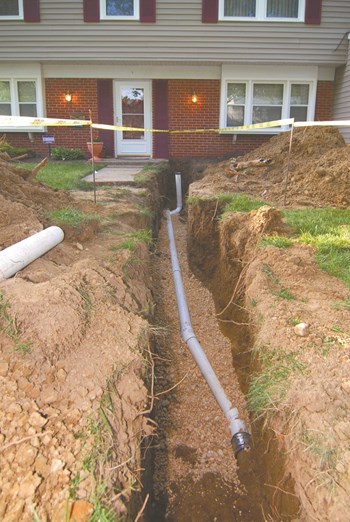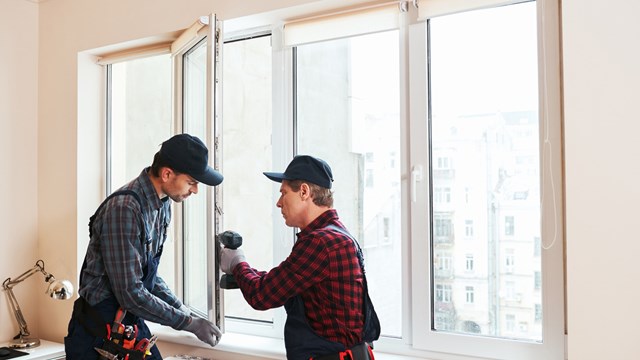
Many New Jersey HOAs were originally built with grading and drainage that for the most part pitched away from buildings, toward a roadway, rear lawn area swale, or sheet flow drainage area, ultimately collecting in a storm water retention or detention facility. Unfortunately, poor design, deficient surface grading, limited drainage structures and/or poor soils used in an attempt to reduce overall construction costs often resulted in deficient drainage, leading to marshy conditions or pooling water.
More Than Meets the Eye
Both new and aged HOA communities should take pains to properly identify and repair deficient drainage conditions on their property. Newly constructed communities have the luxury of the developer-to-board transition process to help repair their drainage deficiencies, and usually the input of an engineer who can examine possible drainage problems early on, and with a critical eye.
That being said, transitioning communities must do more than merely rely upon a visual inspection to determine whether an area is draining properly. Existing marshiness, especially in new construction, is not the only telltale sign of a drainage problem. The size of the drainage area, the amount of runoff entering it, soil types and conditions, grade slopes, and swale definition must all be assessed and analyzed as contributing factors
Usually, all areas of a new site—especially newly sodded areas—will appear to be draining properly because the fresh sod often soaks up or obscures excess water. Many times the deficient drainage areas only become obvious through visible marshiness or maintenance difficulty years after the community is complete, and the deficient areas have been continually saturated.
Site grading and drainage—including storm water detention facilities—should be designed and constructed to allow the areas to drain efficiently over time. Low-lying or flat areas that have poor soil with slow or no permeability will be constantly saturated after storm events. Over time, these areas will become unsightly and impossible to maintain. Relying on an untrained eye to give the final verdict on an area can spell major future headaches for the association as trouble arises and repair costs start to add up.
Storm water detention facilities are also often misdiagnosed as healthy and adequately drained during an association’s transition period. Typical design standards indicate a two percent minimum bottom slope for detention basins to ensure proper drainage and to prevent lawn saturation and ponding problems. Over time, the permeability of the basin bottoms—their “recharge capability”—is reduced by the buildup of silt and oil deposits. Improper grading of a detention basin bottom will eventually cause the basin to become saturated and un-maintainable.
If ponding results from saturation problems, the standing, stagnant water can become a haven for insects and rodents, both of which can lead to health hazards like West Nile virus, to name just one example. To prevent these issues, grades should be checked by survey during the transition analysis, and repairs should be made accordingly.
Beware the Quick Fix
As an association embarks on any drainage repair project, naturally the first step is to determine the cause or causes of the drainage problems. A professional analysis defining the source of the problem is needed, so it’s vital that HOAs work with reputable, experienced engineers and contractors who can formulate a workable action plan, communicate it clearly to the community, and carry it out in a timely and efficient manner.
Investigations should include the analysis of the existing soils, the amount of runoff entering the problem area, existing drainage structure locations, existing underground utility locations, existing grades, and the overall extent of the problem. Proper materials (inlet type, pipe types and sizes, underdrains, etc.) and construction methods must be identified and employed to truly resolve the problem. Too many times, a less costly “Band-Aid” repair is made using inadequate materials and/or design, and the drainage deficiencies either still exist, or reoccur in short order.
Prevention of the above scenario is simple. Any drainage remediation project can be undertaken and completed with a high quality final work product and limited inconvenience to the community—but only if proper, cost effective design and construction specifications are prepared for the proposed improvement. Each community is different, and each has individual elements that require special attention. Generic, one-size-fits-all engineering and design specifications do not exist, and making use of such a mechanism may—and often does—result in more problems, either immediately or in the future.
For example, small plastic drains and shallow piping are often used as a less-expensive quick fix for an HOAs drainage problems, even though these systems are really not effective for larger drainage deficiencies. Plastic drains are very limited in size, and are subject to continued damage from landscaping equipment. In addition the small diameter discharge pipes have limited capacity and are subject to silt buildup, clogging, and damage due to lack of cover and pipe slope. Small plastic drain systems are typically intended for small landscaped flower beds and are simply not an effective means of draining large areas. Nevertheless, some HOAs make use of them in an effort to save money—usually to their detriment in the long run.
In the End
And as with any maintenance-related problem, drainage deficiencies only worsen with the passage of time. Aging communities are frequently left with the responsibility of correcting drainage and grading problems not dealt with during the initial post-development transition period. Upon closer examination by an experienced professional, what might have originally seemed like a straightforward problem can turn out to be much more complicated—and expensive. Too many times community associations make hasty or unadvised decisions regarding these projects, and the end result is an unacceptable condition requiring still more remedial action.
Efficient, individualized designs and specifications with proper inspection reduce the likelihood of the types of headaches mentioned here. An individual design should always be the solution to any remediation project, but are particularly vital when it comes to drainage trouble. Any repair should always include a detailed analysis, an exact plan, and specification of the repair to ensure a positive, effective result for the community.
The expense for a professional site analysis and appropriate repairs are monies well spent—the correct repairs will be final solutions, increase the overall aesthetic appeal of your HOA, improve maintainability, and save money in the long run. Experienced professionals, effective design and qualified contractors are essential in achieving the desired quality final product for the community.
Andrew Amorosi, P.E., R.S., is a professional engineer and reserve specialist with The Falcon Group, an architectural engineering firm located in Bridgewater, New Jersey.






Leave a Comment